高考英语情态动词语法知识点与用法
- 格式:docx
- 大小:41.12 KB
- 文档页数:8
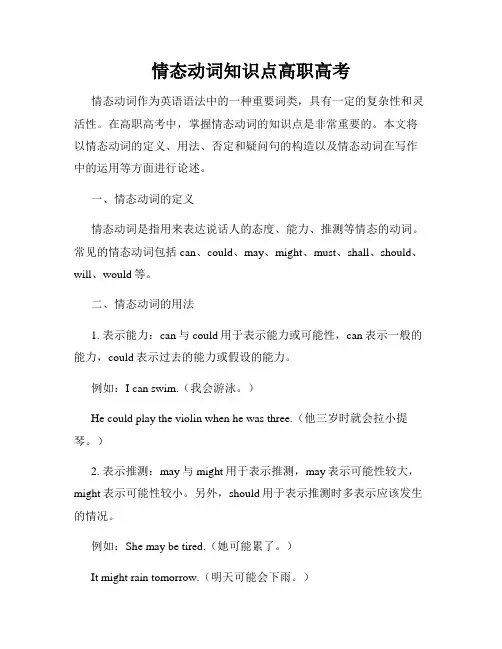
情态动词知识点高职高考情态动词作为英语语法中的一种重要词类,具有一定的复杂性和灵活性。
在高职高考中,掌握情态动词的知识点是非常重要的。
本文将以情态动词的定义、用法、否定和疑问句的构造以及情态动词在写作中的运用等方面进行论述。
一、情态动词的定义情态动词是指用来表达说话人的态度、能力、推测等情态的动词。
常见的情态动词包括can、could、may、might、must、shall、should、will、would等。
二、情态动词的用法1. 表示能力:can与could用于表示能力或可能性,can表示一般的能力,could表示过去的能力或假设的能力。
例如:I can swim.(我会游泳。
)He could play the violin when he was three.(他三岁时就会拉小提琴。
)2. 表示推测:may与might用于表示推测,may表示可能性较大,might表示可能性较小。
另外,should用于表示推测时多表示应该发生的情况。
例如:She may be tired.(她可能累了。
)It might rain tomorrow.(明天可能会下雨。
)He should be studying right now.(他现在应该在读书。
)3. 表示义务或建议:must与should用于表示义务或建议,must表示强制性的义务或必然发生的情况,should表示适当或理所当然的建议。
例如:You must finish your homework before you go out to play.(你必须在外出玩之前完成作业。
)You should eat more fruits and vegetables for a healthy diet.(为了健康的饮食,你应该多吃水果和蔬菜。
)三、情态动词的否定形式情态动词的否定形式是在情态动词前加not。
此外,构成否定句时,主语与情态动词之间需要加入助动词do。
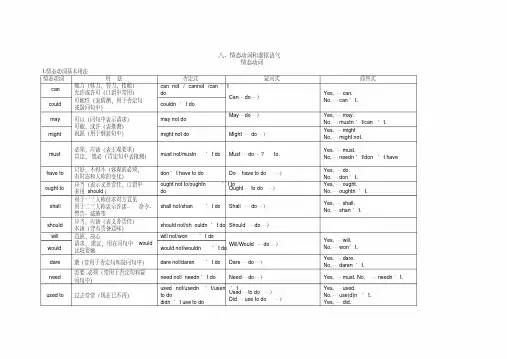
八、情态动词和虚拟语气情态动词I.情态动词基本用法情态动词用法否定式疑问式简答式can 能力(体力,智力,技能)允许或许可(口语中常用)可能性(表猜测,用于否定句或疑问句中)can not / cannot /can’tdoCan…do…?Yes,…can.No,…can’t.could couldn’t domay 可以(问句中表示请求)可能,或许(表推测)祝愿(用于倒装句中)may not doMay…do…?Yes,…may.No,…mustn’t/can’t.might might not do Might…do…?Yes,…might No,…might not.must 必须,应该(表主观要求)肯定,想必(肯定句中表推测)must not/mustn’t do Must…do…? to.Yes,…must.No,…needn’t/don’t havehave to 只好,不得不(客观的必须,有时态和人称的变化)don’t have to do Do…have to do…?Yes,…do.No,…don’t.ought to 应当(表示义务责任,口语中多用should)ought not to/oughtn’t todoOught…to do…?Yes,…ought.No,…oughtn’t.shall 用于一三人称征求对方意见用于二三人称表示许诺、命令、警告、威胁等shall not/shan’t do Shall…do…?Yes,…shall.No,…shan’t.should 应当,应该(表义务责任)本该(含有责备意味)should not/sh ouldn’t do Should…do…?will 意愿,决心请求,建议,用在问句中would比较委婉will not/won’t doWill/Would…do…?Yes,…will.No,…won’t.would would not/wouldn’t dodare 敢(常用于否定句和疑问句中)dare not/daren’t do Dare…do…?Yes,…dare. No,…daren’t.need 需要,必须(常用于否定句和疑问句中)need not/needn’t do Need…do…?Yes,…must. No,…needn’t.used to 过去常常(现在已不再)used not/usedn’t/usen’tto dodidn’t use to doUsed…to do…?Did…use to do…?Yes,…used.No,…use(d)n’t.Yes,…did.No,…didn’t. II.情态动词的重点知识表示“能力、许可”的can和may 表示能力的情态动词用can/couldA computer_____think for itself; it must be told what to do.A.can’tB.must n’tC.may notD.might not表示许可时用may/might ,can/could 都可以,但在问句中用could…?或might…?以使口气委婉客气,其回答一定要用can或may,以使回答口气明确(must表示一定,必须,mustn’t表示禁止,不许可)。
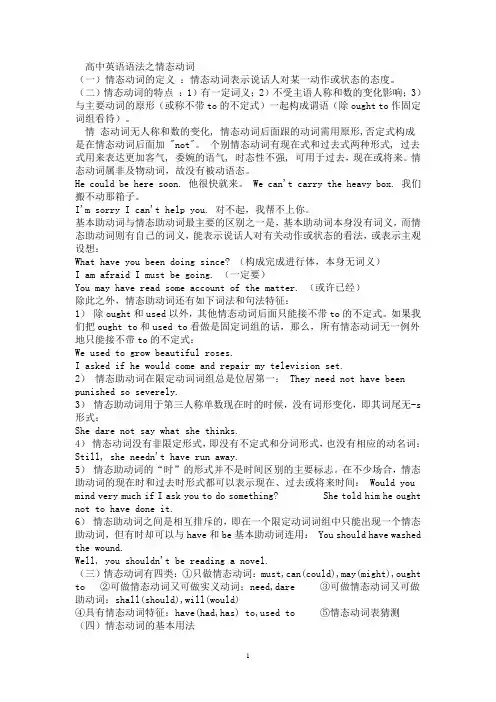
高中英语语法之情态动词(一)情态动词的定义:情态动词表示说话人对某一动作或状态的态度。
(二)情态动词的特点:1)有一定词义;2)不受主语人称和数的变化影响;3)与主要动词的原形(或称不带to的不定式)一起构成谓语(除ought to作固定词组看待)。
情态动词无人称和数的变化, 情态动词后面跟的动词需用原形,否定式构成是在情态动词后面加 "not"。
个别情态动词有现在式和过去式两种形式, 过去式用来表达更加客气, 委婉的语气, 时态性不强, 可用于过去,现在或将来。
情态动词属非及物动词,故没有被动语态。
He could be here soon. 他很快就来。
We can't carry the heavy box. 我们搬不动那箱子。
I'm sorry I can't help you. 对不起,我帮不上你。
基本助动词与情态助动词最主要的区别之一是,基本助动词本身没有词义,而情态助动词则有自己的词义,能表示说话人对有关动作或状态的看法,或表示主观设想:What have you been doing since? (构成完成进行体,本身无词义)I am afraid I must be going. (一定要)You may have read some account of the matter. (或许已经)除此之外,情态助动词还有如下词法和句法特征:1)除ought和used以外,其他情态动词后面只能接不带to的不定式。
如果我们把ought to和used to看做是固定词组的话,那么,所有情态动词无一例外地只能接不带to的不定式:We used to grow beautiful roses.I asked if he would come and repair my television set.2)情态助动词在限定动词词组总是位居第一: They need not have been punished so severely.3)情态助动词用于第三人称单数现在时的时候,没有词形变化,即其词尾无-s 形式:She dare not say what she thinks.4)情态动词没有非限定形式,即没有不定式和分词形式,也没有相应的动名词:Still, she needn't have run away.5)情态助动词的“时”的形式并不是时间区别的主要标志。
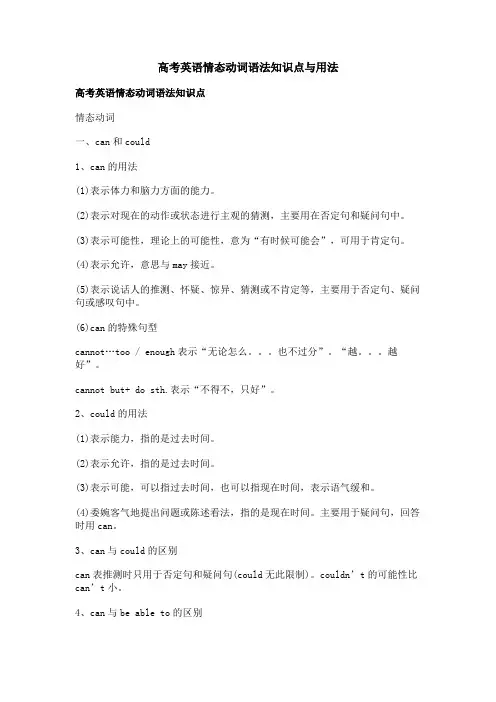
高考英语情态动词语法知识点与用法高考英语情态动词语法知识点情态动词一、can和could1、can的用法(1)表示体力和脑力方面的能力。
(2)表示对现在的动作或状态进行主观的猜测,主要用在否定句和疑问句中。
(3)表示可能性,理论上的可能性,意为“有时候可能会”,可用于肯定句。
(4)表示允许,意思与may接近。
(5)表示说话人的推测、怀疑、惊异、猜测或不肯定等,主要用于否定句、疑问句或感叹句中。
(6)can的特殊句型cannot…too / enough表示“无论怎么。
也不过分”。
“越。
越好”。
cannot but+ do sth.表示“不得不,只好”。
2、could的用法(1)表示能力,指的是过去时间。
(2)表示允许,指的是过去时间。
(3)表示可能,可以指过去时间,也可以指现在时间,表示语气缓和。
(4)委婉客气地提出问题或陈述看法,指的是现在时间。
主要用于疑问句,回答时用can。
3、can与could的区别can表推测时只用于否定句和疑问句(could无此限制)。
couldn’t的可能性比can’t小。
4、can与be able to的区别(1)现在时:无区别,但后者不常用。
(2)完成时;can没有完成时,此时要用have(has,had)been able to。
(3)将来时:can没有将来时,要用will be able to。
(4)过去时:could表示一般能力,was/were able to 表示在具体场合通过努力成功做成某事的能力。
二、may 和might1、may的用法(1)表示询问或说明一件事可不可以做。
(2)表示一件事或许会发生或某种情况可能会存在,通常用在肯定句和否定句中。
注意:表示可能性时,can’t语气强,表示“不可能”,may not语气弱,表示“可能不”。
2、might的用法(1)表示询问或允许,指的是过去时间。
(2)表示可能发生的事,可以指过去时间,也可以指现在时间,语气更加不肯定,可能性比may小一些。
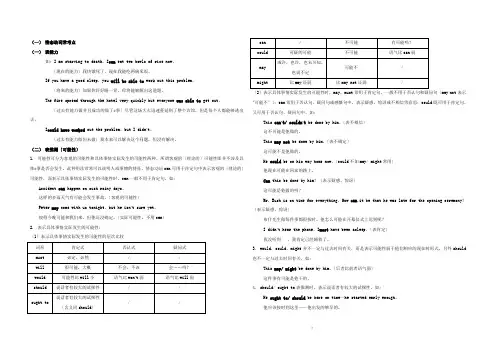
(一)情态动词常考点(一)表能力如:I am starving to death。
I can eat two bowls of rice now。
〔现在的能力〕我快饿死了,现在我能吃两碗米饭。
If you have a good sleep,you will be able to work out this problem。
〔将来的能力〕如果你好好睡一觉,你将能够解出这道题。
The fire spread through the hotel very quickly but everyone was able to get out。
〔过去有能力做并且成功的做了*事〕尽管这场大火迅速蔓延到了整个宾馆,但是每个人都能够逃出去。
I could have worked out the problem,but I didn’t。
〔过去有能力做但未做〕我本来可以解决这个问题,但没有解决。
(二)表推测〔可能性〕1.可能性可分为客观的可能性和具体事情实际发生的可能性两种。
所谓客观的〔理论的〕可能性即并不涉及具体*事是否会发生,此种用法常常可以说明人或事物的特征。
情态动词can可用于肯定句中表示客观的〔理论的〕可能性,而表示具体事情实际发生的可能性时,can一般不用于肯定句。
如:Accident can happen on such rainy days。
这样的多雨天气有可能会发生事故。
〔客观的可能性〕Peter may come with us tonight,but he isn’t sure yet。
彼得今晚可能和我们来,但他还没确定。
〔实际可能性,不用can〕2.表示具体事情实际发生的可能性:〔1〕表示具体事情实际发生的可能性的层次比较〔2〕表示具体事情实际发生的可能性时,may,must常用于肯定句,一般不用于否认句和疑问句〔may not表示"可能不〞〕;can常用于否认句、疑问句或感慨句中,表示疑惑、惊讶或不相信等意思;could既可用于肯定句,又可用于否认句、疑问句中。
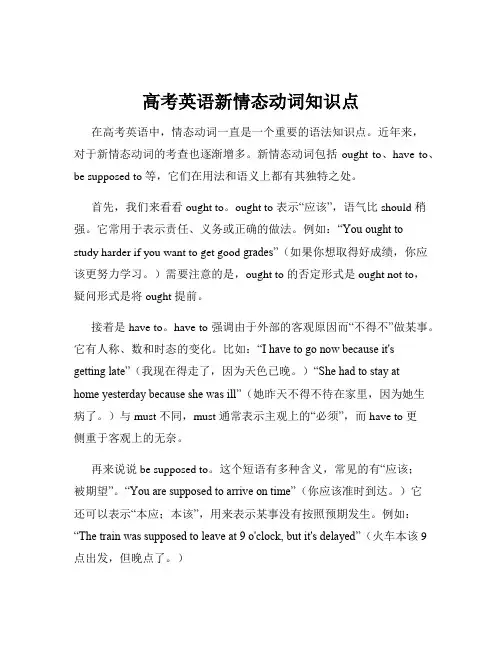
高考英语新情态动词知识点在高考英语中,情态动词一直是一个重要的语法知识点。
近年来,对于新情态动词的考查也逐渐增多。
新情态动词包括 ought to、have to、be supposed to 等,它们在用法和语义上都有其独特之处。
首先,我们来看看 ought to。
ought to 表示“应该”,语气比 should 稍强。
它常用于表示责任、义务或正确的做法。
例如:“You ought to study harder if you want to get good grades”(如果你想取得好成绩,你应该更努力学习。
)需要注意的是,ought to 的否定形式是 ought not to,疑问形式是将 ought 提前。
接着是 have to。
have to 强调由于外部的客观原因而“不得不”做某事。
它有人称、数和时态的变化。
比如:“I have to go now because it's getting late”(我现在得走了,因为天色已晚。
)“She had to stay athome yesterday because she was ill”(她昨天不得不待在家里,因为她生病了。
)与 must 不同,must 通常表示主观上的“必须”,而 have to 更侧重于客观上的无奈。
再来说说 be supposed to。
这个短语有多种含义,常见的有“应该;被期望”。
“You are supposed to arrive on time”(你应该准时到达。
)它还可以表示“本应;本该”,用来表示某事没有按照预期发生。
例如:“The train was supposed to leave at 9 o'clock, but it's delayed”(火车本该 9 点出发,但晚点了。
)在具体的语境中,这些新情态动词的运用需要我们仔细分辨。
比如,在表达建议时,ought to 可能更合适;在强调客观条件限制时,have to 更为准确;而 be supposed to 则在描述期望和规定方面用得较多。
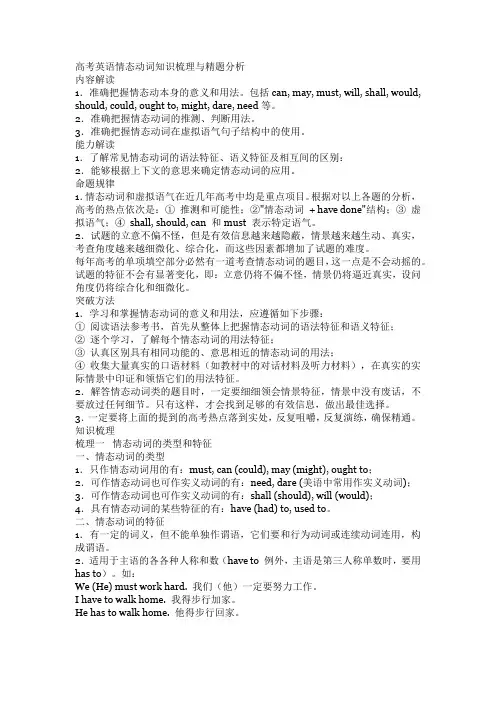
高考英语情态动词知识梳理与精题分析内容解读1.准确把握情态动本身的意义和用法。
包括can, may, must, will, shall, would, should, could, ought to, might, dare, need等。
2.准确把握情态动词的推测、判断用法。
3.准确把握情态动词在虚拟语气句子结构中的使用。
能力解读1.了解常见情态动词的语法特征、语义特征及相互间的区别:2.能够根据上下文的意思来确定情态动词的应用。
命题规律1.情态动词和虚拟语气在近几年高考中均是重点项目。
根据对以上各题的分析,高考的热点依次是:①推测和可能性;②"情态动词+ have done"结构;③虚拟语气;④shall, should, can 和must 表示特定语气。
2.试题的立意不偏不怪,但是有效信息越来越隐蔽,情景越来越生动、真实,考查角度越来越细微化、综合化,而这些因素都增加了试题的难度。
每年高考的单项填空部分必然有一道考查情态动词的题目,这一点是不会动摇的。
试题的特征不会有显著变化,即:立意仍将不偏不怪,情景仍将逼近真实,设问角度仍将综合化和细微化。
突破方法1.学习和掌握情态动词的意义和用法,应遵循如下步骤:①阅读语法参考书,首先从整体上把握情态动词的语法特征和语义特征;②逐个学习,了解每个情态动词的用法特征;③认真区别具有相同功能的、意思相近的情态动词的用法;④收集大量真实的口语材料(如教材中的对话材料及听力材料),在真实的实际情景中印证和领悟它们的用法特征。
2.解答情态动词类的题目时,一定要细细领会情景特征,情景中没有废话,不要放过任何细节。
只有这样,才会找到足够的有效信息,做出最佳选择。
3.一定要将上面的提到的高考热点落到实处,反复咀嚼,反复演练,确保精通。
知识梳理梳理一情态动词的类型和特征一、情态动词的类型1.只作情态动词用的有:must, can (could), may (might), ought to;2.可作情态动词也可作实义动词的有:need, dare (美语中常用作实义动词);3.可作情态动词也可作实义动词的有:shall (should), will (would);4.具有情态动词的某些特征的有:have (had) to, used to。
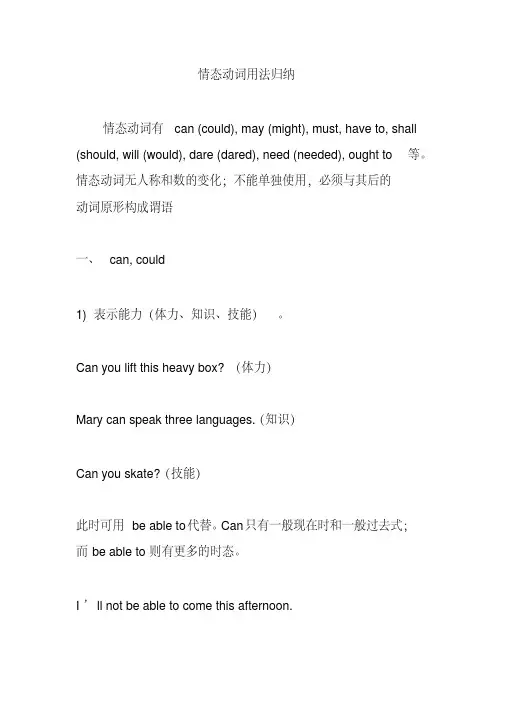
情态动词用法归纳情态动词有can (could), may (might), must, have to, shall (should, will (would), dare (dared), need (needed), ought to等。
情态动词无人称和数的变化;不能单独使用,必须与其后的动词原形构成谓语一、can, could1) 表示能力(体力、知识、技能)。
Can you lift this heavy box?(体力)Mary can speak three languages.(知识)Can you skate?(技能)此时可用be able to代替。
Can只有一般现在时和一般过去式;而be able to则有更多的时态。
I’ll not be able to come this afternoon.当表示“经过努力才得以做成功某事”时应用be able to,不能用Can。
如:He was able to go to the party yesterday evening in spite of the heavy rain.2) 表示请求和允许。
-----Can I go now?----- Yes, you can. / No, you can’t.此时可与may互换。
在疑问句中还可用could,might代替,不是过去式,只是语气更委婉,不能用于肯定句和答语中。
---- Could I come to see you tomorrow?---- Yes, you can. ( No, I’m afraid not. )3) 表示客观可能性(客观原因形成的能力)。
They’ve changed the timetable, so we can go by bus instead.This hall can hold 500 people at least.4) 表示推测(惊讶、怀疑、不相信的态度),用于疑问句、否定句和感叹句中。
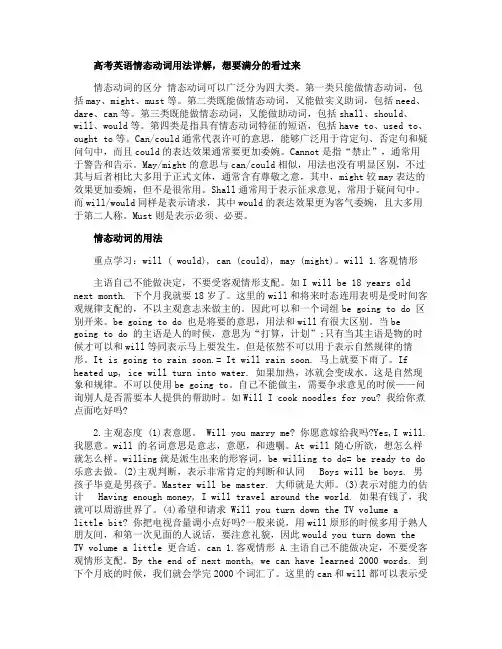
高考英语情态动词用法详解,想要满分的看过来情态动词的区分情态动词可以广泛分为四大类。
第一类只能做情态动词,包括may、might、must等。
第二类既能做情态动词,又能做实义助词,包括need、dare、can等。
第三类既能做情态动词,又能做助动词,包括shall、should、will、would等。
第四类是指具有情态动词特征的短语,包括have to、used to、ought to等。
Can/could通常代表许可的意思,能够广泛用于肯定句、否定句和疑问句中,而且could的表达效果通常要更加委婉。
Cannot是指“禁止”,通常用于警告和告示。
May/might的意思与can/could相似,用法也没有明显区别,不过其与后者相比大多用于正式文体,通常含有尊敬之意,其中,might较may表达的效果更加委婉,但不是很常用。
Shall通常用于表示征求意见,常用于疑问句中。
而will/would同样是表示请求,其中would的表达效果更为客气委婉,且大多用于第二人称。
Must则是表示必须、必要。
情态动词的用法重点学习:will ( would), can (could), may (might)。
will 1.客观情形主语自己不能做决定,不要受客观情形支配。
如I will be 18 years old next month. 下个月我就要18岁了。
这里的will和将来时态连用表明是受时间客观规律支配的,不以主观意志来做主的。
因此可以和一个词组be going to do 区别开来。
be going to do 也是将要的意思,用法和will有很大区别。
当be going to do 的主语是人的时候,意思为“打算,计划”;只有当其主语是物的时候才可以和will等同表示马上要发生,但是依然不可以用于表示自然规律的情形。
It is going to rain soon.= It will rain soon. 马上就要下雨了。
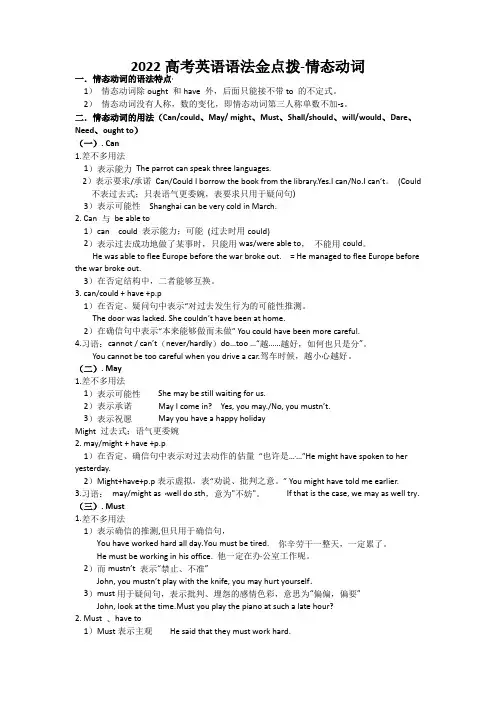
2022高考英语语法金点拨-情态动词一.情态动词的语法特点1)情态动词除ought 和have 外,后面只能接不带to 的不定式。
2)情态动词没有人称,数的变化,即情态动词第三人称单数不加-s。
二.情态动词的用法(Can/could、May/ might、Must、Shall/should、will/would、Dare、Need、ought to)(一). Can1.差不多用法1)表示能力The parrot can speak three languages.2)表示要求/承诺Can/Could I borrow the book from the library.Yes.I can/No.I can’t。
(Could 不表过去式;只表语气更委婉,表要求只用于疑问句)3)表示可能性Shanghai can be very cold in March.2. Can 与be able to1)can could 表示能力;可能(过去时用could)2)表示过去成功地做了某事时,只能用was/were able to,不能用could。
He was able to flee Europe before the war broke out.= He managed to flee Europe before the war broke out.3)在否定结构中,二者能够互换。
3. can/could + have +p.p1)在否定、疑问句中表示“对过去发生行为的可能性推测。
The door was lacked. She couldn’t have been at home.2)在确信句中表示“本来能够做而未做” You could have been more careful.4.习语:cannot / can’t(never/hardly)do…too …“越……越好,如何也只是分”。
You cannot be too careful when you drive a car.驾车时候,越小心越好。

情态动词知识梳理情态动词的基本用法:can/could*表具备某种能力叱can表现在能力;could表示过去能力;可用be able to代替;was/were able to表示成功做了某事。
*表请求和允许叱请求用could语气委婉,答语不用couldo*表猜测的•可能性"吐can用于否定和疑问句(could不限);can(be)表示有时候会(常与sometimes,at times 连用)may/might*表请求和允许计请求用might语气更委婉:,允许时用may,表示•可以11(表示允许时不用might)。
六表猜测性,可能性。
"也许"叱此意常用于肯定句(might可能最小)。
六表祝愿吐固定句型为"May+主语+d。
":May you succeed!must*表“必须"wmust多表主观、现在、将来义务;have to多表客观、过去义务;mustrYt表噤止”;否定用needn't/don't have to。
介表推测。
肯定是、准是.吐只用于肯定句。
will/would六表意愿,决心等w would此时为will过去式,无意义差别。
六表经常性,习惯性,倾向性。
叱would表过去反复的动作/某种倾向。
(相对于used to,would do无"现已没有此习惯”之义。
)*表功能.性质叱叙述真理,如:The tree will live without water for3months.女表猜测11想必,大概•(只是时态区别)吐表对目前事物的预料。
如:That will be the postman ringing(would表示过去/现在;will 表示现在/将来)六表“请求/要求-(Will yoiP)用于疑问句,常与you连用。
如:Will you give me a piece of paper9shall(否:shan't)六表征求意见•…好不好.*用在第一、三人称°如:Shall the reporters wait outside or what9六表允诺、威胁、警告、命令或根据规定有义务做吐用于第二、第三人称。
高中英语语法:情态动词10条学习要点“could+have+过去分词”用法全面归纳有关情态动词的10条学习要点1. 弄清基本语法特点情态动词就是表示说话的语气或情态的动词。
常见的情态动词有can, may, must, need, dare, shall, will, should, ought to, have to, used to, had better, would rather等。
情态动词具有以下3个特点:(1)情态动词后面接动词原形并与动词原形一起构成谓语。
(2)情态动词虽有时态的变化,但却没有人称和数的变化,即情态动词不会因为主语的人称或单复数的不同而用不同的形式。
(3)变为疑问句或否定句时不需要助动词,而是将情态动词移至主语前变为疑问句,直接在情态动词后加not,构成否定句。
2. 弄清表示能力的can / could和be able to的用法(1)can表示具有某种能力或技能,意为“能,会”。
如:Who can answer this question? 谁能回答这个问题?(2)can 的过去式为could,但它通常只表示过去一般性能力,不表示过去特定场合下的能力,遇此情况要用was [were] able to。
如:I could run faster then. 我那时能跑得更快一些。
They were able to jump into the sea before the boat was blown up. 他们在船爆之前跳入海里。
3. 弄清表示许可的can / could / may / might / must的用法can / could / may / might均可表示许可,只不过may较侧重讲话人的许可,而can较侧重客观情况的许可;could / might的语气比can / may更委婉、客气;在答语中表示允许别人做某事要can / may,不能用could / might。
高考英语语法复习情态动词与虚拟语气知识讲解一、情态动词(1)表示能力时,can只用于一般现在时,could仅用于一般过去时;而be able to则有更多的时态,如将来时、完成时等。
I haven’t been able to read that report yet.He will be able to skate as well as you.(2)Was/were able to表示能力时,侧重经过努力而成功做到某事;而could仅表示具备能力,不说明是否实施了能力。
He studied hard and was able to pass the exam.(3)用在其他动词,如might,may,would,want,hope等之后表示能力只能用be able to。
He might be able to fix your car.(1)must还可以表示质问或感情色彩,意为“偏要,偏偏”。
Why must it snow on Saturday?(2)should还可以表示惊奇、愤怒、失望等特殊情感,尤其用在以why,who,how等开头的疑问句中或某些感叹句中。
why should you be so late today?(1)must作“必须”讲的一般疑问句,其肯定回答用must,否定回答用needn’t或don’t have to。
-Must I pay now?-Yes, you must./No, you needn’t.(2)need还可以作实义动词,有人称和数的变化,后跟带to的不定式作宾语。
She needed to go out for a walk.(1)两者在表示过去的习惯动作或行为时常可通用。
When we were children, we would/used to go skating every winter.(2)Used to与would都不能与表示具体频率、次数的词及特定的时间状语或具体的一段时间连用。
高考英语之情态动词用法和虚拟语气知识点和范例一、can和could1、can的用法(1)表示体力和脑力方面的能力。
(2)表示对现在的动作或状态进行主观的猜测,主要用在否定句和疑问句中。
(3)表示可能性,理论上的可能性,意为“有时候可能会”,可用于肯定句。
(4)表示允许,意思与may接近。
(5)表示说话人的推测、怀疑、惊异、猜测或不肯定等,主要用于否定句、疑问句或感叹句中。
(6)can的特殊句型cannot…too / enough表示“无论怎么。
也不过分”。
“越……越好”。
cannot but+ do sth.表示“不得不,只好”。
2、could的用法(1)表示能力,指的是过去时间。
(2)表示允许,指的是过去时间。
(3)表示可能,可以指过去时间,也可以指现在时间,表示语气缓和。
(4)委婉客气地提出问题或陈述看法,指的是现在时间。
主要用于疑问句,回答时用can。
3、can与could的区别can表推测时只用于否定句和疑问句(could无此限制)。
couldn't的可能性比can't小。
4、can与be able to的区别(1)现在时:无区别,但后者不常用。
(2)完成时;can没有完成时,此时要用have(has,had)been able to。
(3)将来时:can没有将来时,要用will be able to。
(4)过去时:could表示一般能力,was/were able to 表示在具体场合通过努力成功做成某事的能力。
二、may 和might1、may的用法(1)表示询问或说明一件事可不可以做。
(2)表示一件事或许会发生或某种情况可能会存在,通常用在肯定句和否定句中。
注意:表示可能性时,can't语气强,表示“不可能”,may not 语气弱,表示“可能不”。
2、might的用法(1)表示询问或允许,指的是过去时间。
(2)表示可能发生的事,可以指过去时间,也可以指现在时间,语气更加不肯定,可能性比may小一些。
高考英语冲刺情态动词的意义与用法在高考英语中,情态动词是一个重要的语法知识点,对于理解和表达英语句子的含义起着关键作用。
在冲刺阶段,掌握情态动词的意义和用法,能够帮助我们更准确地答题,提高英语成绩。
情态动词本身有一定的词义,表示说话人的情绪、态度或语气,但不能单独作谓语,只能和其他动词原形一起构成谓语。
常见的情态动词有 can、could、may、might、must、shall、should、will、would、ought to 等。
先来说说 can 和 could 。
“can”表示能力,意为“能,会”,比如“He can speak English very well”(他英语说得很好。
);也可以表示可能性,意为“可能”,“The weather can be very changeable in spring”(春天的天气可能变化无常。
)“could”是“can”的过去式,但在很多情况下,“could”的语气比“can”更加委婉,例如“Could you please help me?”(您能帮帮我吗?)接着是 may 和 might 。
“may”表示允许、许可,“You may go now”(你现在可以走了。
)也可以表示可能性,不过可能性比“can”要小,“It may rain tomorrow”(明天可能会下雨。
)“might”是“may”的过去式,语气比“may”更加委婉、不确定,“I thought it might be useful”(我觉得它可能有用。
)“must”表示必须,“You must finish your homework before watching TV”(你必须在看电视前完成作业。
)它的否定形式“mustn't”表示禁止,“You mustn't smoke here”(你禁止在这里吸烟。
)需要注意的是,“must”表示推测时,语气非常肯定,“He must be very tired after such a long walk”(走了这么长的路,他一定很累了。
语法专项情态动词一.情态动词的含义:情态动词只有情态意义,即表示说话人对动作的观点,如需要,可能,意愿或怀疑等。
情态动词主要有:can(could), may(might), must, shall(should), will(would), need, dare(dared), have to(had to),ought to, had better,would rather, used to等。
二.情态动词的特征:1.在形式上,情态动词没有实义动词的各种变化,只有could, would, had to, might, should等几个过去式。
其他如must, ought to等的过去式皆与现在式同形,且在各种人称后都用同样的形式。
2.在意义上,大多数情态动词有多个意义。
如can可表示“能够”,“可能”,“允许”等。
3.在用法上。
情态动词(除ought后接不定式外)与助动词一样,后接动词原形构成谓语动词。
三.情态动词的用法:(一)can/could的用法:1.表示能力:①表示现在的能力用can;表示过去的一般能力用could,若表示过去经过努力而做成某事,则用was/were able to do sth. 或managed to do sth. 或succeeded in doing sth.---Everyone here can speak English. (现在的能力)---A fire broke out in the hotel last night, but everyone was able to escape. (经过努力做成某事)②表示将来的能力常不用can,而用will be able to的将来时态:---I’ll be able to speak French in another few months.2.表示请求许可:若表示请求别人允许自己做某事,can/could均可,could表示委婉语气。
高考英语情态动词语法知识点与用法高考英语情态动词语法知识点情态动词一、can和could1、can的用法1表示体力和脑力方面的能力。
2表示对现在的动作或状态进行主观的猜测,主要用在否定句和疑问句中。
3表示可能性,理论上的可能性,意为“有时候可能会”,可用于肯定句。
4表示允许,意思与may接近。
5表示说话人的推测、怀疑、惊异、猜测或不肯定等,主要用于否定句、疑问句或感叹句中。
6can的特殊句型cannot…too / enough表示“无论怎么。
也不过分”。
“越。
越好”。
cannot but+ do sth.表示“不得不,只好”。
2、could的用法1表示能力,指的是过去时间。
2表示允许,指的是过去时间。
3表示可能,可以指过去时间,也可以指现在时间,表示语气缓和。
4委婉客气地提出问题或陈述看法,指的是现在时间。
主要用于疑问句,回答时用can。
3、can与could的区别can表推测时只用于否定句和疑问句could无此限制。
couldn’t的可能性比can’t 小。
4、can与be able to的区别1现在时:无区别,但后者不常用。
2完成时;can没有完成时,此时要用havehas,hadbeen able to。
3将来时:can没有将来时,要用will be able to。
4过去时:could表示一般能力,was/were able to 表示在具体场合通过努力成功做成某事的能力。
二、may 和might1、may的用法1表示询问或说明一件事可不可以做。
2表示一件事或许会发生或某种情况可能会存在,通常用在肯定句和否定句中。
注意:表示可能性时,can’t语气强,表示“不可能”,may not语气弱,表示“可能不”。
2、might的用法1表示询问或允许,指的是过去时间。
2表示可能发生的事,可以指过去时间,也可以指现在时间,语气更加不肯定,可能性比may小一些。
3、may与might的特殊用法1“may+主语+动词原形”表示祝愿。
2“may/ might well+动词原形”表示完全能,很可能。
3“may/ might as well+动词原形”表示最好,满可以,倒不如。
4may be 是“情态动词+系动词be”结构,表示“可能有,可能在”,否定式为may not be。
maybe是一个词,为副词,意为“大概,或许,可能”,在句中作状语。
三、must的用法1、表示“必须”,多强调说话人的主观看法。
2、must和have to 的区别:1must表示说话人的义务或说话人主观认为“必须,应当”做某事;have to表示由于某种外界原因而“必须,不得不”做某事。
即must侧重说明主观看法,have to强调客观需要。
2must只有一种形式,可用于现在、过去或将来时,但have to有不同的形式,可用于不同的时态。
3在否定句中,don’t need to, don’t have to, needn’t表示没有义务;mustn’t表示禁止。
3、must的否定形式must not/ mustn’t 意为“不许,禁止”,表示绝对禁止。
若表示“没必要,不必”,应使用needn’t或don’t have to。
注意:对must作否定回答时,不用mustn’t,用needn’t或don’t have to。
4、must 表示“偏偏”,指令人不快的事情。
5、must用来表示推测,意为i“准是,肯定是”,一般用于肯定句,肯定程度比may,might大的多。
四、need的用法1、need用作情态动词,后面接动词原形,通常用在否定句和疑问句中。
2、回答need时,肯定回答用must,否定回答用needn’t或don’t have to。
3、need用作实义动词时,有时态、人称和数的变化,后面加to do。
4、need to do和need doingneed to do中不定式的逻辑主语就是主句的主语;need doing是主动形式表示被动含义,即need前的主语就是need后面的动词所表示的动作的承受者。
注意:want和require作“需要”讲时,和need的用法相同。
5、needn’t have done与didn’t need to doneedn’t have done表示过去本不必做但实际上却做了某事didn’t need to do表示过去不必做而实际上也没做某事五、dare的用法1、dare用作情态动词,后面接动词原形,通常用在否定句和疑问句和条件句中;它没有人称和数的变化,但有过去式dared。
2、dare用作实义动词时,有时态、人称和数的变化,后面加to do。
注意:1I dare say意为“我认为,我相信,很可能”。
2dare用作实义动词时,表示“敢冒危险,不俱”。
3dare可用于激将或挑战。
例:He dared me to jump down.六、will和would1、will的用法1可以表示主观意志、意愿,可用于各种人称。
2可以表示经常性、习惯性、倾向性等,意为“经常,惯于,总是”。
3表示命令说话这确信命令一定会得到执行或允诺。
4will可用于祈使句的附加疑问句。
5用于疑问句,表“邀请,请求”,常与第二人称you连用。
2、would的用法1作为will的过去时态,用于过去时中,表示主观愿望或意志,意为“愿意,执意”。
2用与第二人称,表示谦恭的请求或征求意见,比will更为客气。
3表示过去的习惯,后接动词原形,意为“总是,总会”。
4would表意愿用于词组中。
Would like “喜欢,想要”=would loveWould rather “宁愿”。
七、shall和should1、shall的用法1shall用于第一、三人称陈述句中,表示说话人征求对方的意见或向对方请示。
2shall用于第二、第三人称陈述句中,表示说话人给对方的命令、警告、允诺或威胁。
3用于所有人称,表示规章、法令、预言等,可译为“必须”。
2、should的用法1表示义务、责任或劝告、建议、命令等,意为“应该”。
2表示有一定根据的推测、推论或可能性,意为“可能,该”肯定的语气没有must表推测时强。
3多用于疑问句中,表示惊讶、难以相信或不应该的事。
4ought to和should的比较A、ought to也可以表示推论、可能性,和should用法一样。
B、在省略回答中,ought to中的to可以省略。
C、should和ought to表示做正确的事情或理应做的事情。
be supposed to 意为“被期望,应该”,表示被期望发生或根据安排、要求做某事,或认为做某事是正常的。
八、had better 意为“最好”,’d better为其缩写形式,其后续跟动词原形。
注意:had better 的否定形式had better not。
九、used to “过去常常”,仅用于过去时态中,通常用于所有人称。
1、used to +动词原形,表示过去有规律的习惯或过去某一时期的的状况,但现在已不存在。
2、其反意疑问句简略回答中,也有两种形式:didn’t ,usedn’t3、used to 和would的区别1used to 可表示过去经常发生的动作或存在的状态,而would仅表示过去习惯性或重复性的动作。
2used to 强调过去的行为同现在的对比,含有“过去如此,现在已不再这样了”之意。
Would仅表示过去习惯性动作,没有预先在对比的含义。
3used to不能跟表确定时间短的时间状语连用。
4used to 可用于无人称句和存在句,而would则不可。
4、used to与be used to do和be used to doing1used to表示“过去常常”隐含现在不这样了,其中to是不定式符号,后跟动词原形,仅用于过去时态。
2be/get/become used to 表示“习惯于”时,意为“变得习惯于“或“开始习惯于”。
3be used to do表示“被用来”。
十、情态动词后的某些动词形式1、情态动词+have done1“must+have+done”表示对过去事情的肯定推测,译成“一定做过某事”,该结构只用于肯定句。
2“can't+have+done”表示对过去事情的否定推测,译成“不可能做过某事”。
3“can+have+done”表示对过去行为的怀疑,用于疑问句,译成“可能做过……吗?”4“could+have+done”是虚拟语气,表示对过去事情的假设,意思是本来能够做某事而没有做。
5“may+have+done”表示对发生过的事情的推测,意思是“可能已经”或“也许已经”,用于肯定句中。
6“might+have+done”表示对过去事情的推测,might与may意思相同,多用于虚拟语气结构中;还可以表示“本来可能……”。
7“would+have+done”虚拟语气,表示对过去事情的假设,意思是“本来会做”。
8“should+have+done”意思是“本来应该做某事,而实际没做。
” “shouldn't + have+done”表示本来不应该做某事,而实际做了。
含有指责对方或自责的含意。
9“ought to+have+done”表示过去应该做而实际并没有做,译成“理应做……”,往往表示遗憾。
与“should+have+done”用法基本一样。
10“need+have+done”表示本来需要做某事而没有做。
“needn't+have+done”则表示“本来不需要做某事而做了”。
2、情态动词+be doing:表示对现在正在做的事情的推测。
十一、含有某些情态动词的反意疑问句1、must当must表示命令时,反意疑问句用needn’t。
当must表示推测时,反意疑问句与实际情况保持一致,即与把must删掉后的陈述句的反意疑问句保持一致。
2、can’t当can’t表示没能力做某事时,反意疑问句用can sb.?当ca n’t用于表推测时,反意疑问句由实际情况决定,即由去掉can’t后的真实陈述句决定。
情态动词的用法.1. dare、need、mustdare是很“争强好胜”的情态动词,举个例子:Don’t you dare!你敢吗?或 How dare you tell her about that?你怎么敢告诉她那件事!是不是感受到腾腾的杀气扑面而来!need也是一个比较极端的词,含有命令的口吻,用的时候要小心了。
比如You need this.你需要这个这句话可能会让你的朋友感觉不舒服,同样的意思,换成Would you like this?你想要这个吗?是不是好多了!must通常也是命令的口吻,它的否定形式mustn’t表示禁止,如果不是非常严肃需要强调的时候尽量避免使用,可以尝试用will/would替换,举个例子:You must come with us.你必须和我们一起去。